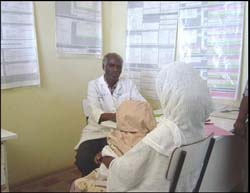
Photo: USAID/Eritrea
A woman and her child receive IMCI counseling from a trained practitioner.
In just seven years, Eritrea has improved its immunization coverage from among the worst to among the best in the developing world.
|
Initiative
USAID provides approximately $2.5 million annually to improve maternal and child health in Eritrea. As part of this larger assistance program, the Ministry of Health (MoH) identified several key areas in which USAID could make a contribution to improving immunization and child health. USAID, through a $2.3 million grant, helped to supply both equipment and training in the implementation and management of an expanded program for immunization.
USAID also assisted the MoH to begin the implementation of integrated management of childhood illness (IMCI). With USAID help, the MoH conducted a baseline survey to determine the ability of health facilities and health workers to implement IMCI. Over 500 health care providers at all levels of the health care system were trained in IMCI case management.
|


